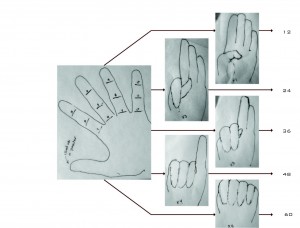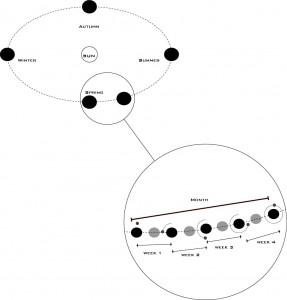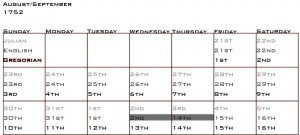


Sexagesimal
The passing of time is kept track of by most living things. Trees have rings growing a new one each year, shells grow another layer displaying their age, sedimentary rock can display minerals form centuries ago. As humans we do not show age in such a clear way, instead we developed the calendar. This has always been our device for keeping track of what occurred, and the order of which it occurred.
Before the calendar could be developed first there had to be a method of counting. The first method was of base 60 or sexagesimal. This system was developed by the Sumerians using the one thing that was always with them, their bodies.
They would use one hand to count to 12 by using their knuckles and the other to keep track of the number of times that 12 was reached.
The Sun and the Moon
The calendar first started was first started to track the seasons for once agriculture was developed The harvest became an essential part of people’s lives, dictating their schedules.
The early Babylonians would follow the sun for the days, keeping track of short periods of time, a day. The moon was followed for the seasons of the harvest as the original basis of the months. Then as a longer period still was the year. In each year there were twelve months, with each month being 28 days, the length of a moon cycle each year would progressively end earlier, from the year only being 336 days. This caused each year to earlier in the rotation around the sun than the pervious.
There were a few methods of fixing this. One was to add a thirtieth month, called the intercalary month.
The Egyptians also had a twelve month calendar based off the cycles of the moon which they corrected slightly differently. They lengthened their months to 30 days each, though still used the lunar calendar for religious purposes. They also added a thirtieth month to at the end of the year which was only five days. These last five days of the year were used as feast days
Weeks were developed in the 6th century BC by the Babylonians as a sub division of the month. To have a period that was longer than a day, but shorter than a month. The week is also based off of the moon, One week represents a phase of the moon. With 28 days in the moon cycle and four phases in each cycle that left the week with 7 days in each.
Julian vs Gregorian
The next development in the calendar was made by Julius Caesar. In 45 BC the leap year was introduced as one day added to the end of every fourth year. He numbered the months to the number of days that are currently in each month. He also readjusted the calendar to begin the year with January as opposed to March. This accounts for September, October, November, and December meaning the seventh,eighth, ninth, and tenth month respectively. Originally January and February were the eleventh and twelfth months.
The last change that Julius made was the renaming the month of July from Quintilius (fifth month) to Julius after him. Augustus choose to do the same with Sextilius when he gained power. They enjoyed the summer months.
Through the years the Julian calendar fell out of sync with the actual year because it had not accounted for the fact that a year is not exactly 365.24 days but instead is approximately 365.24219. Because of this in 1582 pope Gregory xiii had a correction for this developed.
The Gregorian Calendar, the calendar that we use today. First had Italy readjust the calendar to jump forward 10 days. To stop the calendar from moving off again the leap year was reworked. Now every century year is no longer a leap year except for centuries that are divisible by 400. This correction the calendar is still not perfect but the calendar will only be ahead by 3 days after ten thousand years.
Readjusting the calendar was a difficult ordeal for many countries, All correcting at different times
England 1752
The English were not pleased that they lost 11 days of September 1752. They felt as though they had been robbed of 11 days of their lives. One day it was September 2nd and the next it was September 14th. Really they were all only day older but people and their perception of time felt as though they had grown 11 days older over night. At the time England begun their new year In march, beginning on March 25, known as Lady Day or England’s tax day, When 11 days were “lost” the government had to move the tax day by 11 days as well to avoid riots. this is why England’s tax day is April 6th today.
Sweden 1753
Sweden wanted to change to the Gregorian in 1700 and made a forty year plan to do it. The country decided that they were going to not take part in leap years for forty years to make up for the ten days. This meant that they would not be on either the Julian nor the Gregorian for the forty years between 1700 and 1740. The country would become one day closer every four years to aligning with the Gregorian calendar. This plan did not work for they did not abstain from the leap year in either 1704 or 1708. In 1712, still only one day off Sweden decided to return to the Julian and added a February 30th for that year.